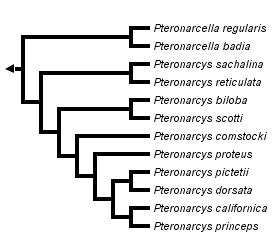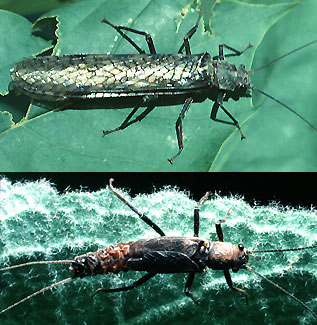Pteronarcyidae
Giant Stoneflies
C. Riley Nelson


This tree diagram shows the relationships between several groups of organisms.
The root of the current tree connects the organisms featured in this tree to their containing group and the rest of the Tree of Life. The basal branching point in the tree represents the ancestor of the other groups in the tree. This ancestor diversified over time into several descendent subgroups, which are represented as internal nodes and terminal taxa to the right.

You can click on the root to travel down the Tree of Life all the way to the root of all Life, and you can click on the names of descendent subgroups to travel up the Tree of Life all the way to individual species.
For more information on ToL tree formatting, please see Interpreting the Tree or Classification. To learn more about phylogenetic trees, please visit our Phylogenetic Biology pages.
close boxIntroduction
Pteronarcyidae, the giant stoneflies, are physically the largest of the stoneflies, but there are only 12 known species. They occur in the Nearctic Region and eastern Palearctic Region, but are noticeably absent from Europe.
They are often found in medium to large rivers, but some species can more frequently be found in smaller streams. They are a favorite with fly fishermen who tie imitatins of both the nymphs and the adults. When the "hatch" of Pteronarcys californica is on, the trout eat little else.
Characteristics
Zwick (1973) lists the synapomorphies of the Pteronarcyidae as: 1, ventral lobe reduced; 2, trachea leading from head to cervical gills; 3, postfurcal gills present. Uchida & Isobe (1989) state that the arolium of the pretarsus is expanded laterally, with a pair of lateral sclerites.
Discussion of Phylogenetic Relationships
C. H. Nelson (1988) produced the tree given on this page using strict parsimony and the character coding gleaned from all available sources. He found it to be 92 steps in length. He also produced several other, somewhat longer trees as alternatives and reanalyzed the data of Stark & Szczytko (1982). Stark & Szczytko's tree was 99 steps long and based largely on egg characters.
References
Nelson, C. H. 1988. Note on the phylogenetic systematics of the family Pteronarcyidae (Plecoptera), with a description of the eggs and nymphs of the Asian species. Ann. Entomol. Amer. 81: 560-576.
Stark, B. P. and S. W. Szczytko. 1982. Egg morphology and phylogeny in Pteronarcyidae (Plecoptera). Ann. Entomol. Soc. Amer. 75: 519-529.
Uchida, S. and Y. Isobe. 1989. Styloperlidae, stat. nov. and Microperlinae, subfam. nov. with a revised system of the family group Systellognatha. Spixiana 12: 145-182.
Zwick, P. 1973. Insecta: Plecoptera. Phylogenetisches System und Katalog. Das Tierreich 94. Walter de Gruyter and Co., Berlin. 465 pp.
About This Page
C. Riley Nelson

Brigham Young University, Provo, Utah, USA
Page copyright © 1996
All Rights Reserved.
Citing this page:
Nelson, C. Riley. 1996. Pteronarcyidae. Giant Stoneflies. Version 01 January 1996 (under construction). http://tolweb.org/Pteronarcyidae/13946/1996.01.01 in The Tree of Life Web Project, http://tolweb.org/








 Go to quick links
Go to quick search
Go to navigation for this section of the ToL site
Go to detailed links for the ToL site
Go to quick links
Go to quick search
Go to navigation for this section of the ToL site
Go to detailed links for the ToL site